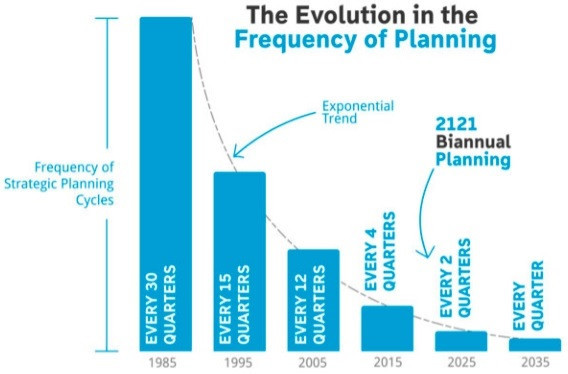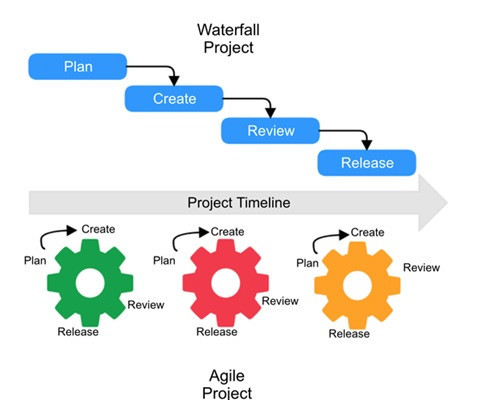A common theme in virtually every facet of life is that the pace of change is accelerating. This post is about how the pace of change is affecting strategic planning cycles in a way that closely parallels the transition of project management methodologies from waterfall to agile. This article shows that strategic planning cycles are collapsing as waterfall project planning collapses into short agile cycles.
The evolution of strategy parallels the evolution of project management, both driven by the continual acceleration of the pace of change. The implication is that both planning and execution cycles need to be in sync with the pace of change and with each other.
Collapsing Strategic Planning Cycles
The strategic planning cycle is exhibiting a collapse in the frequency of planning and rethinking strategy. The Evolution of Strategy ~ A 2020 Reboot published the following graphic which illustrates the trend.

This figure illustrates the collapsing time frames of organizations for regrouping to review and update organizational strategy. I find it amazing that back in 1985, the frequency of strategic planning cycles was every thirty (30) quarters, and that in only ten (10) years, in 1995, that was cut in half to fifteen (15) quarters. It seems clear that the proliferation of personal computers and related digital technologies was the primary cause of that shortening of planning cycle time frames.
With the gradual maturing of the internet since that period, planning cycles have decreased even further, to the point where it is predicted that by 2025 strategy planning cycles will be quarterly!
The next section shows how this phenomenon closely resembles the collapse of project planning cycles – from the waterfall approach to the agile approach.
Collapsing Cycles in Project Planning and Execution
A waterfall approach could easily involve a 2-year planning phase for a project, followed by a 2-year execution period, with measurement of performance based upon metrics designed in the plan. That means that such a project’s success metrics would have been devised 4 years prior to completion of the project!
—————————————-
I recommend these PM templates (paid link):
—————————————-
That’s not a very effective methodology when, in the world in which you are working, strategic planning cycles have collapsed on average to less than a year! Instead, an agile approach with much more frequent planning cycles seems like the better way to go. This is exactly what continues to evolve in project management.
The following diagram shows how a waterfall managed project flows orderly from stage to stage – one long serial Plan-Create-Review-Release cycle. The assumption with the waterfall method is that the plan at the start was correct. However, with collapsing strategic planning cycles driven by the pace of change, that’s a very risky assumption.
The diagram, from A Comprehensive Guide to Agile Project Management – Setting your team up for success, by THE REDBOOTH TEAM APRIL 26TH, 2018, shows the agile process paralleling the waterfall process. It illustrates the collapsing of the Plan-Create-Review-Release cycle into more frequent intervals. The agile approach accounts for the reality that change happens, and provides the ability to evolve the project, allowing pivots when necessary.

It has been said that the only thing for certain is change. Like the evolution of strategic planning cycles to much shorter time frames, the transition in project management from waterfall to agile methodologies acknowledges the certainty of change.
Every Industry and Situation is Different
The ideas above illustrate this concept of change and how planning and execution are handling it – but in a generalized, macro way. In practice, however, the situation is different in every industry. There is a vast difference, for example, in how things are done in the metal fabricating industry that in the software industry. The pace of change in the metal fabricating industry would make strategic frameworks such as Michael Porter’s Five Forces more relevant, where the pace of change in the software industry would more closely match frameworks related to Power and Strategy.
The reality is that the pace of change is different in every industry. Strategic planning cycles in the metal fabricating industry are likely to be longer than they are in the software industry. Likewise, using waterfall project management in the metal fabricating industry may be appropriate and effective, but doing so in the software industry would not work well. Instead, using agile methodologies in the software industry is much more effective.
The pace of change is also different across companies in an industry. Even within an industry, competitors use different strategies that affect the length of the strategy planning cycles, which in turn affect the choice of project methodologies to be used. A traditional competitor in the metal fabricating industry may find that it is best to focus on areas that are minimally effected by digital technology, and thus longer strategy planning cycles and waterfall are appropriate. Other companies in that same industry might be following a strategy related to the internet of things, where they are increasing the digital content embedded in their fabricated products. In that case, shorter planning cycles and agile project management would probably be a better practice.
Finally, the pace of change can also be very different for different parts of the organization. For example, again in the metal fabricating example, there may be a more traditional side of the business that is minimally effected by digital technology, and another part of the business that is deeply effected by it. It would be appropriate to have longer planning cycles and use waterfall in the former more traditional side, while the latter part of the company should use shorter planning cycles coupled with more agile methodologies for implementation.
The Evolution of Strategy: Implications for Projects
Project management practitioners must be cognizant of the interplay between strategy and implementation and how it affects their projects.
Strategic planning cycles and project management methodologies must both be in sync with the pace of change in the space in which they are playing – and must be in sync with each other. Strategic planning cycles that are either too frequent or not frequent enough in the face of change in the area of operation will lose some effectiveness. Likewise, project implementation that does not track and acknowledge the pace of change in the space also is problematic, and a hybrid approach is usually the solution.
It is equally important for project success to be cognizant of synchronization – or lack thereof – between the cycles of implementation and the cycles of strategic planning because they are both subject to the same forces of change. Less frequent planning cycles coupled with more agile implementation is not ideal. Frequent planning cycles with traditional waterfall implementation is also problematic.
The Way Ahead for Strategy and Project Management
In the face of accelerating change in nearly all markets, organizations, and facets of life, strategy planning cycles and project management methodologies are keeping pace by collapsing cycles into tighter time frames. The forecast for the evolution of strategy is to follow a path of tighter and tighter time cycles for planning. In sync with that, the evolution of project management will need to have tighter time cycles for the plan-create-review-release process, and thus will continue to follow a path from traditional waterfall methodologies to agile methodologies.
—————————————-
I recommend these strategy resources (paid link):
—————————————-

